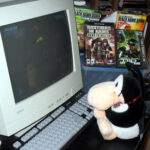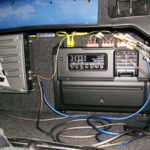With dozens and dozens of choices out there now in the crowded low-power “boutique” tube-amplifier game, I would like to give you my review of two of the best, the Fender Blues Junior and the Mesa/Boogie Subway Blues amplifiers. Both of these little monsters are fantastic amps and any guitarist would be smart to own one or the other, but every contest has to have a winner so hopefully I can give you the tools you need to ehlp kae an informed choice if you are in the market for an amp like this.
The Fender Blues Junior has become an extremely popular amp for Fender in the last few years, and with good reason. The Junior is a 15W all-tube, single-channel combo amp with a single 12″ Fender Special Design speaker. The controls are pretty standard- Reverb,Master,Middle,Bass,Treble and Volume, with a push-button “Fat” switch. It has a single input and a toggle on/off switch with no standby, which is a small problem for me as I like the standby mode on a tube amp. The Fender Blues Junior is pretty classic Fender from a visual standpoint. It is covered in black Tolex and sports the standard silver Fender grillcloth. It’s an attractive amp and is pretty heavy for it’s size. It is obviously a solidly-built amp, which you would expect it to coming from Fender.
The Mesa/Boogie Subway Blues is a slightly smaller and lighter amp than the Blues Junior, but is similar in many ways. The Subway Blues is a 20W all-tube,single-channel combo amp with a 10″ Eminence Black Shadow speaker. Mesa took simplicity to the max (or min.) on this amp. You have Volume, Treble, Midrange, Bass and Reverb. Some versions of the Subway Blues have two inputs- one Bright and one Fat. The version I own has a single input with a Bright/Fat toggle switch. The Mesa/Boggie also has an on/off toggle as well as a standby toggle, which is a plus in my book. Visually the Mesa/Boogie is pretty typical Mesa. It is covered in black vinyl with black grillcloth with the classic Mesa/Boogie logo in silver. A nice touch is the leather corner protectors on the Subway.
Both amps are extremely well-constructed, just as you’d expect them to be based on the two companies’ reputations. Both are also very compact and relatively light when compared to lugging a Twin or a Marshall around. But the real measure of an amp is it’s sound and you won’t be disappointed with either if you love a pure, tube-driven tone.
I have not owned a Fender Blues Junior personally, but have played through a number of them and have several friends who own them so I feel qualified to comment on the sound this am produces. First of all, the first thing you will notice is that this amp is well-named. It is a blues amp first amd foremost. It has a very warm and naturally compressed tone that really breaks up nicely when you dig into it. It sounds fantastic with a number of guitars, but Strats and Blues Juniors are a match made in blues heaven. This amp sounds very nice with just a hint of overdrive and even better with more than a hint. Of course the reverb is very nice, being a Fender. This a very loud little amp for 15watts and will handle most any gig you want to throw at it if you mic it. The only negative I have to offer is that it can be a bit bright when cranked up, especially with a Tele. Overall, it’s a sweet-sounding amp and very much suited to blues.
The Mesa/Boogie Subway Blues is currently the only amp I own and is perfect for me. It is almost impossible to believe the amount of air this little beast can push with 20 watts and single 10″ speaker. The Subway is not a particularly versatile amp. It’s a blues amp, hence the name. This amp sounds great clean with no effects whatsoever, and especially with reverb turned up a little. This is one of the best reverb tanks out there, rivaling anything Fender has. Where the Subway Blues really sets itself apart, though, is when it is cranked up. This thing comes alive after the volume knob is past twelve ‘o clock. It becomes extremely sensitive to pick attack, allowing you to articulate very well with chords or to dig in and allow it to become very aggresive and overdriven, without adjusting anything. Playing a Strat in the neck pick-up position with the volume up is as close to the perfect blues tone as I’ll ever find. I also find a nice classic rock tone using a Boss DS-1 to give it a bit more dirt. Surprisingly, the 10″ speaker handles a lot of abuse and continues to shine. I am looking forward to adding a single 12″ or dual 12″ extension cabinet to add a little bottom-end fullness to the Subway Blues. As with the Fender, the Mesa lacks a little in the area of fullness of tone due to the speaker limitations, but both have plenty of power to handle a bigger load.
In conclusion, both of these things are amazing amps and you won’t go wrong with either, but I have to give the edge to the Mesa/Boogie Subway Blues. The tone this little amp produces is simply jaw-dropping and has to be heard to be believed. You aren’t going to be playing any Korn or Metallica with either of these amps, but if blues and killer tone are your cups of tea, get off your can and go buy one of these two.
The Fender Blues Junior is still being produced today and is readily available for under $400.00. Sadly, the Mesa/Boogie Subway Blues is no longer being produced, but can be found used fairly easily. The prices are rising steadily as more people discover this amp, but you can find them commonly in the $400-500 range, with occasional deal under $400. Either way, it’s money well spent in my opinion.



